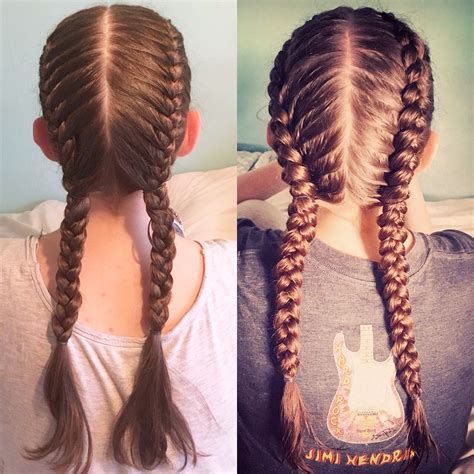French Braid vs. Dutch Braid: A Detailed Comparison
Introduction:
Braiding is an ancient skill that has been used for centuries to create intricate and beautiful hairstyles. Among the most popular braiding techniques are the French braid and the Dutch braid. These two braids share a similar structure but differ in their appearance and execution. Understanding their differences can help you choose the right braid for your hair type and style.

Table 1: Key Differences between French and Dutch Braids
| Feature | French Braid | Dutch Braid |
|---|---|---|
| Placement | Braid starts from the crown of the head | Braid starts from the nape of the neck |
| Appearance | Braid is woven over and under | Braid is woven under and over |
| Volume | Braid appears flatter and tighter | Braid appears more voluminous and raised |
| Complexity | Relatively easier to learn | Requires a bit more practice |
Construction Techniques:
French Braid:
- Divide your hair into three equal sections at the crown of your head.
- Cross the right section over the middle section.
- Cross the left section over the new middle section.
- Pick up a small section of hair from the right side and add it to the right section.
- Cross the augmented right section over the middle section.
- Pick up a small section of hair from the left side and add it to the left section.
- Cross the augmented left section over the new middle section.
- Repeat steps 4-7 until you reach the nape of your neck.
- Secure the braid with an elastic band.
Dutch Braid:
- Divide your hair into three equal sections at the nape of your neck.
- Cross the right section under the middle section.
- Cross the left section under the new middle section.
- Pick up a small section of hair from the right side and add it to the right section.
- Cross the augmented right section under the middle section.
- Pick up a small section of hair from the left side and add it to the left section.
- Cross the augmented left section under the new middle section.
- Repeat steps 4-7 until you reach the crown of your head.
- Secure the braid with an elastic band.
Which Braid is Right for Me?
The French braid is generally considered more suitable for beginner braiders, as it is relatively easier to learn. It creates a flatter and tighter braid that is ideal for everyday hairstyles.
The Dutch braid, on the other hand, is more complex but results in a more voluminous and raised braid. It is commonly used in intricate hairstyles, such as updos and buns.
Common Mistakes to Avoid
When Braiding French or Dutch Braids:
- Pulling too tightly: This can cause pain and damage your hair.
- Not picking up enough hair: The braid will look thin and loose.
- Crossing the sections incorrectly: This will result in a messy and uneven braid.
- Tugging on the sections: This can break the hair strands.
- Not securing the braid properly: The braid may come undone or slip loose.
Benefits of French and Dutch Braids
- Versatile styling: Can be incorporated into various hairstyles.
- Improved hair health: Braiding can distribute hair oils, preventing dryness and breakage.
- Protection for hair: Braided hair is less prone to tangling and damage.
- Enhanced appearance: Braids can add volume, texture, and style to your hair.
Recent Innovations in Braiding Techniques
- Inverted French/Dutch Braids: The braid is woven from the bottom up.
- Half-Up French/Dutch Braids: Only a portion of the hair is braided.
- Cascade Braids: Multiple small braids are created within a larger braid.
- Fishtail Braids: A variant that creates a fishbone-like appearance.
Table 2: Benefits of French and Dutch Braids
| Benefit | Description |
|---|---|
| Versatility | Can be incorporated into various hairstyles |
| Improved hair health | Distributes hair oils, preventing dryness and breakage |
| Protection for hair | Less prone to tangling and damage |
| Enhanced appearance | Adds volume, texture, and style |
Conclusion
The French braid and the Dutch braid are two classic braiding techniques with unique characteristics. Whether you prefer a flatter and tighter braid or a more voluminous and raised one, these braids offer endless styling possibilities. By understanding the differences and mastering the techniques, you can create beautiful and intricate braids that enhance your appearance and protect your hair.
Table 3: Common Mistakes to Avoid When Braiding
| Mistake | Description |
|---|---|
| Pulling too tightly | Can cause pain and hair damage |
| Not picking up enough hair | Results in a thin and loose braid |
| Crossing sections incorrectly | Causes a messy and uneven braid |
| Tugging on the sections | Can break hair strands |
| Not securing the braid properly | May come undone or slip loose |
Table 4: Recent Innovations in Braiding Techniques
| Technique | Description |
|---|---|
| Inverted French/Dutch Braids | Woven from the bottom up |
| Half-Up French/Dutch Braids | Only a portion of hair is braided |
| Cascade Braids | Creates multiple smaller braids within a larger braid |
| Fishtail Braids | Creates a fishbone-like appearance |
